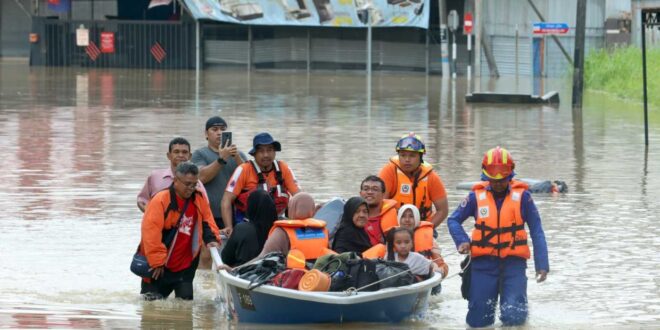PETALING JAYA: The northeast monsoon floods which started in November last year is ongoing with parts of the country still on alert for floods.
As of January 13, there were 5,666 people seeking shelter at 41 evacuation centres in Johor and Pahang.
The number of flood evacuees peaked at nearly 30,000 in late December and the floods have claimed the lives of three people so far, according to figures from the National Disaster Management Agency,
Here’s a recap on the monsoon’s progress and some key facts about the country’s rainy weather and floods.
Shifting monsoon rains
The pattern of heavy rains throughout the country can be seen by tracking the continuous rain alerts issued by the Malaysian Meteorological Department (MetMalaysia).
When the monsoon started on November 11, continuous rain lashed northern and eastern peninsular states including Kedah, Kelantan, Terengganu, Pahang and Kedah, along with Sabah.
In late-December, the heavy downpours began to swing to the southern part of Peninsula Malaysia with Johor and Pahang the hardest hit. In east Malaysia, parts of Sarawak were also affected.
The animated map below shows the movement of heavy rains since the start of the monsoon:
Flood impact
The interactive timeline below shows the damage wrought by the floods:
In terms of the number of floods, Sarawak recorded 270 flood incidents in 2022, followed by Kedah (108), Selangor (107) and Terengganu (107), according to the Compendium of Environment Statistics 2023 issued by the Department of Statistics:
Key facts on Malaysia’s monsoons, rains and floods
The word monsoon comes from the Arabic word “musim” which means season, and refers to a seasonal prevailing wind bringing either rain or dry weather in the region of South and Southeast Asia.
MetMalaysia’s website, which explains the origin of the word, states that ancient traders traveling through the Indian Ocean and the Arabian Sea used the word “musim” to describe the alternating wind system that blows during the winters and summers in the northern hemisphere.
Fire and Rescue Department personnel meeting with flood victims at an evacuation centre in Kampung Bukit Tok Bat, Kuala Berang in Terengganu. — BK photo
Malaysia has two monsoon seasons, the southwest monsoon that starts late May to September and the northeast monsoon from November to March.
The northeast monsoon brings heavy rain especially to the states on the east coast of Peninsular Malaysia, west of Sarawak and east of Sabah, while the southwest monsoon relatively shows drier weather.
The transition period between these two monsoons is known as the inter-monsoon phase.
The wettest and driest
According to the compendium of Environment Statistics 2023, the Mulu meteorological station recorded the highest amount of annual rainfall in 2022, at 6,172.8 mm.
The Sitiawan station in Perak meanwhile had the lowest rainfall readings at 1,943 mm.
The following graphics show the top five wettest, driest, coolest, hottest and most lightning prone areas among all the meteorological stations nationwide:
Major floods in Malaysia
The earliest major floods officially recorded hit then Malaya in December 1926. Dozens of people reportedly killed and thousands affected by 50-hour-long heavy rains that started on Christmas night.
Another major flood as in December 1971 which hit Kuala Lumpur, killing 33 with 180,000 people affected.
The Johor floods in December 2006 meanwhile killed 17 and displaced over 100,000 people.
Those living in at-risk areas must be extra careful during floods, as there are many unseen dangers when coming into contact with flood waters like the people living in Kampung Melayu Hilir in Serian, Sarawak, which was hit by floods following heavy rain recently. — ZULAZHAR SHEBLEE/The Star
In December 2014, floods in Kelantan affected over 200,000 people and killed 21, causing RM1bil in damage.
In 2017, Penang was badly hit, with seven people killed and over 9,000 affected. Losses were estimated at RM300,000.
Selangor was badly flooded in December 2021, with 54 deaths and over 200,000 people affected, with losses totaling RM6.1bil.
In July 2022, Baling in Kedah was hit by floods that killed three people with over 1,400 affected.
People trying to cross a flooded road near Sungai Betis at Gua Musang, Kelantan – BK photo
Climate change impact
According to a United Nations report, more areas and people in Malaysia will be made vulnerable to the risk of floods due to climate change.
“The rise of the average annual surface temperature will reach between 1.9 to 2.1°C by the end of the (21st) century,” said the report, titled Flood Management and Climate Change Adaptation In Malaysia.
“With the increase in temperature, the change of average annual precipitation is also expected to increase between 14% to 25%,” the report said.
 BeritaKini.biz Berita Viral Terkini di Malaysia
BeritaKini.biz Berita Viral Terkini di Malaysia





